Synthetic Applications of Aziridinium Ions
Abstract
1. Introduction
2. Synthetic Application of Aziridinium Ions
2.1. Aziridinium Ions by Addition of External Electrophiles
2.2. Aziridinium Ions upon Expulsion of the Leaving Group
2.3. Bicyclic Aziridinium Ions from Substituted Aziridines
2.4. Bicyclic Aziridinium from Ring Contraction of Azaheterocycles
2.5. Aziridinium Ylides
3. Conclusions
Author Contributions
Funding
Conflicts of Interest
References
- Lindstrom, U.M.; Somfai, P. Aminolysis of vinyl epoxides as an efficient entry to N–H vinylaziridines. Synthesis 1998, 109–117. [Google Scholar] [CrossRef]
- Zwanenburg, B.; ten Holte, P. The synthetic potential of three-membered ring aza-heterocycles. Top. Curr. Chem. 2001, 216, 93–124. [Google Scholar]
- Sweeney, J.B. Aziridines: Epoxides’ ugly cousins? Chem. Soc. Rev. 2002, 31, 247–258. [Google Scholar] [CrossRef] [PubMed]
- Hu, X.E. Nucleophilic ring opening of aziridines. Tetrahedron 2004, 60, 2701–2743. [Google Scholar] [CrossRef]
- Tanner, D. Chiral aziridines—Their synthesis and use in stereoselective transformations. Angew. Chem. Int. Ed. Engl. 1994, 33, 599–619. [Google Scholar] [CrossRef]
- McCoull, W.; Davis, F.A. Recent synthetic applications of chiral aziridines. Synthesis 2000, 1347–1365. [Google Scholar] [CrossRef]
- Watson, I.D.G.; Yu, L.; Yudin, A.K. Advances in nitrogen transfer reactions involving aziridines. Acc. Chem. Res. 2006, 39, 194–206. [Google Scholar] [CrossRef]
- Padwa, A.; Murphree, S.S. Epoxides and aziridines-A mini review. Arkivoc 2006, 3, 6–33. [Google Scholar]
- Singh, G.S.; D’hooghe, M.; De Kimpe, N. Synthesis and reactivity of C-heteroatom-substituted aziridines. Chem. Rev. 2007, 107, 2080–2135. [Google Scholar] [CrossRef]
- Pitzer, K.S. Strain energies of cyclic hydrocarbons. Science 1945, 101, 672. [Google Scholar] [CrossRef]
- Lewis, L.L.; Turner, L.L.; Salter, E.A.; Magers, D.H. Computation of the conventional strain energy in oxaziridine. J. Mol. Struct. Theochem. 2002, 592, 161–171. [Google Scholar] [CrossRef]
- Dudev, T.; Lim, C. Ring strain energies from ab initio calculations. J. Am. Chem. Soc. 1998, 120, 4450–4458. [Google Scholar] [CrossRef]
- Morgan, K.M.; Ellis, J.A.; Lee, J.; Fulton, A.; Wilson, S.L.; Dupart, P.S.; Dastoori, R. Thermochemical studies of epoxides and related compounds. J. Org. Chem. 2013, 78, 4303–4311. [Google Scholar] [CrossRef] [PubMed]
- D’hooghe, M.; Ha, H.-J. Synthesis of 4- to 7-Membered Heterocycles by Ring Expansion; Springer: Berlin/Heidelberg, Germany, 2016. [Google Scholar]
- Cherni, E.; Essalah, K.; Besbes, N.; Abderrabba, M.; Ayadi, S. Theoretical investigation of the regioselective ring opening of 2-methylaziridine. Lewis acid effect. J. Mol. Modeling 2018, 24, 309. [Google Scholar] [CrossRef] [PubMed]
- Baruah, B.; Deuri, S.; Phukan, P. Reactivity and regioselectivity in the ring opening of 2-substituted non-activated aziridines: A density functional theory based analysis. Comput. Theor. Chem. 2014, 1027, 197–202. [Google Scholar] [CrossRef]
- Paasche, A.; Arnone, M.; Fink, R.F.; Schirmeiste, T.; Engels, B. Origin of the reactivity differences of substituted aziridines: CN vs. CC bond breakages. J. Org. Chem. 2009, 74, 5244–5249. [Google Scholar] [CrossRef] [PubMed]
- Cossy, J.; Pardo, D.G.; Dumas, C.; Mirguet, O.; Dechamps, I.; Metro, T.-X.; Burger, B.; Roudeau, R.; Appenzeller, J.; Cochi, A. Rearrangement of β-amino alcohols and application to the synthesis of biologically active compounds. Chirality 2009, 21, 850–856. [Google Scholar] [CrossRef]
- Chen, Y.; Sun, X.; Wu, N.; Li, J.; Jin, S.; Zhong, Y.; Liu, Z.; Rogachev, A.; Chong, H.-S. Synthetic and theoretical investigation on the one-pot halogenation of β-amino alcohols and nucleophilic ring opening of aziridinium ions. Org. Biomol. Chem. 2016, 14, 920–939. [Google Scholar] [CrossRef]
- Black, R. Development, Historical Use and Properties of Chemical Warfare Toxicology. In Chemical Warfare Toxicology: Volume 1: Fundamental Aspects; Worek, F., Jenner, J., Thiermann, H., Eds.; Royal Society of Chemistry: Cambridge, UK, 2016; Volume 1, pp. 1–28. [Google Scholar]
- Lodewyk, M.W.; Tantillo, D.J. Nonclassical ammonium ions as intermediates in cinchona alkaloid rearrangement? Chirality 2020, 32, 484–488. [Google Scholar] [CrossRef]
- Ji, M.-K.; Hertsen, D.; Yoon, D.-H.; Eum, H.; Goossens, H.; Waroquier, M.; Van Speybroeck, V.; D’hooghe, M.; De Kimpe, N.; Ha, H.-J. Nucleophile-dependent regio- and stereoselective ring opening of 1-azoniabicyclo [3.1.0]hexane tosylate. Chem. Asian J. 2014, 9, 1060–1067. [Google Scholar] [CrossRef]
- Choi, J.; Yadav, N.N.; Ha, H.-J. Preparation of a stable bicyclic aziridinium ion and its ring expansion toward piperidines and azepanes. Asian J. Org. Chem. 2017, 6, 1292–1307. [Google Scholar] [CrossRef]
- Dechamps, I.; Gomez Pardo, D.; Cossy, J. Synthesis of optically active substituted 3-fluoropiperidines from prolinols by using DAST. Synlett 2007, 263–267. [Google Scholar] [CrossRef]
- Dechamps, I.; Pardo, D.G.; Cossy, J. Ring expansion induced by DAST: Synthesis of substituted 3-fluoropiperidines from prolinols and 3-fluoroazepanes from 2-hydroxymethylpiperidines. Eur. J. Org. Chem. 2007, 4224–4234. [Google Scholar] [CrossRef]
- Silva, M.A.; Goodman, J.M. Aziridinium ring opening: A simple ionic reaction pathway with sequential transition states. Tetrahedron Lett. 2005, 46, 2067–2069. [Google Scholar] [CrossRef]
- Cochi, A.; Pardo, D.G.; Cossy, J. Access to optically active 3-aminopiperidines by ring expansion of prolinols: Thermodynamic versus kinetic control. Eur. J. Org. Chem. 2012, 2023–2040. [Google Scholar] [CrossRef]
- Boydas, E.B.; Tanriver, G.; D’hooghe, M.; Ha, H.-J.; Van Speybroeck, V.; Catak, S. Theoretical insight into the regioselective ring-expansions of bicyclic aziridinium ions. Org. Biomol. Chem. 2018, 16, 796–806. [Google Scholar] [CrossRef] [PubMed]
- D’hooghe, M.; Catak, S.; Stankovic, S.; Waroquier, M.; Kim, Y.; Ha, H.-J.; Van Speybroeck, V.; De Kimpe, N. Systematic study of halide-induced ring opening of 2-substituted aziridinium salts and theoretical rationalization of the reaction pathways. Eur. J. Org. Chem. 2010, 25, 4920–4931. [Google Scholar] [CrossRef]
- Akhtar, R.; Naqvi, S.A.R.; Zahoor, A.F.; Saleem, S. Nucleophilic ring opening reactions of aziridines. Mol. Divers. 2018, 22, 447–501. [Google Scholar] [CrossRef]
- Glowacka, I.E.; Trocha, A.; Wroblewski, A.E.; Piotrowska, D.G. N-(1-Phenylethyl)aziridine-2-carboxylate esters in the synthesis of biologically relevant compounds. Beilstein J. Org. Chem. 2019, 15, 1722–1757. [Google Scholar] [CrossRef] [PubMed]
- Macha, L.; D’hooghe, M.; Ha, H.-J. Deployment of aziridines for the synthesis of alkaloids and their derivatives. Synthesis 2019, 51, 1491–1515. [Google Scholar]
- Lee, W.-K.; Ha, H.-J. High light of the chemistry of enantiomerically pure aziridine-2-carboxylates. Aldrichimica Acta 2003, 36, 57–63. [Google Scholar]
- Pellissier, H. Recent Developments in Asymmetric Aziridination. Adv. Synth. Catal. 2014, 356, 1899–1935. [Google Scholar] [CrossRef]
- Pellissier, H.; Lattanzi, A.; Dalpozzo, R. Asymmetric Synthesis of Three-Membered Rings. Wiley-VCH: Weinheim, Germany, 2017; pp. 205–378. [Google Scholar]
- Dogan, O.; Polat-Cakir, S. Recent progress in asymmetric synthesis of aziridine derivatives (microreview). Chem. Heterocycl. Compd. 2018, 54, 397–399. [Google Scholar] [CrossRef]
- Park, C.S.; Kim, M.S.; Sim, T.B.; Pyun, D.K.; Lee, C.H.; Chang, J.-W.; Ha, H.-J. Novel stereoselctive synthesis of functionalized oxazolidinone from chiral aziridine. J. Org. Chem. 2003, 68, 43–49. [Google Scholar] [CrossRef] [PubMed]
- Kim, Y.; Ha, H.-J.; Yun, H.; Lee, B.K.; Lee, W.K. Ring opening of 2-acylaziridines by acid chlorides. Tetrahedron 2006, 62, 8844–8849. [Google Scholar] [CrossRef]
- Lee, B.K.; Kim, M.S.; Hahm, H.S.; Kim, D.S.; Lee, W.K.; Ha, H.-J. An efficient synthesis of chiral terminal 1,2-diamines using an enantiomerically pure [1-(1′R)-methylbenzyl]aziridine-2-yl]methanol. Tetrahedron 2006, 62, 8393–8397. [Google Scholar] [CrossRef]
- Shin, S.-H.; Han, E.Y.; Park, C.S.; Lee, W.K.; Ha, H.-J. Stereoselective synthesis of enantiomerically pure D-threo-PDMP.; Manipulation of a core unit of 1,2-diaminoalcohol. Tetrahedron 2000, 11, 3293–3301. [Google Scholar] [CrossRef]
- Kim, Y.; Ha, H.-J.; Yun, S.Y.; Lee, W.K. Preparation of stable aziridinium ions and their ring openings. Chem. Commun. 2008, 36, 4363–4365. [Google Scholar] [CrossRef]
- Kim, Y.; Yoon, D.-H.; Ha, H.-J.; Kang, K.Y.; Lee, W.K. N-Methylative aziridine ring opening and asymmetric synthesis of MeBmt. Tetrahedron Lett. 2011, 52, 5918–5920. [Google Scholar] [CrossRef]
- Yoon, D.-H.; Kang, P.; Lee, W.K.; Kim, Y.; Ha, H.-J. Alkylative ring opening of N-methylaziridinium ions and a formal synthesis of tyroscherin. Org. Lett. 2012, 14, 429–431. [Google Scholar] [CrossRef]
- Lee, J.; Lee, J.-E.; Ha, H.-J.; Son, S.I.; Lee, W.K. N-methylative aziridine ring opening: Asymmetric synthesis of hygroline, pseudohygroline and hygrine. Tetrahedron Lett. 2015, 56, 856–858. [Google Scholar] [CrossRef]
- Jung, J.-H.; Kim, S.; Eum, H.; Lee, W.K.; Ha, H.-J. N-methylative aziridine ring opening and the synthesis of (S)-3-methylamino-3-[(R)-pyrrolidin-3-yl]propanenitrile. Tetrahedron 2017, 73, 5993–5999. [Google Scholar] [CrossRef]
- Yun, S.Y.; Catak, S.; Lee, W.K.; D’hooghe, M.; De Kimpe, N.; Van Speybroeck, V.; Waroquier, M.; Kim, Y.; Ha, H.-J. Nucleophile-dependent regioselective ring opening of 2-substituted N,N-dibenzylaziridinium ions: Bromide versus hydride. Chem. Commun. 2009, 18, 2508–2510. [Google Scholar] [CrossRef] [PubMed]
- Berger, G. Using conceptual density functional theory to rationalize regioselectivity: A case study on the nucleophilic ring-opening of activated aziridines. Comp. Theor. Chem. 2013, 1010, 11–18. [Google Scholar] [CrossRef]
- Catak, S.; D’hooghe, M.; Verstraelen, T.; Hemelsoet, K.; Van Nieuwenhove, A.; Ha, H.-J.; Waroquier, M.; Van Speybroeck, V.; De Kimpe, N. Opposite regiospecific ring opening of 2-(Cyanomethyl)aziridines by hydrogen bromide and benzyl bromide: Experimental study and theoretical rationalization. J. Org. Chem. 2010, 75, 4530–4541. [Google Scholar] [CrossRef] [PubMed]
- Stankovic, S.; D’hooghe, M.; Catak, S.; Eum, H.; Waroquier, M.; Van Speybroeck, V.; De Kimpe, N.; Ha, H.-J. Regioselectivity in the ring opening of non-activated aziridines. Chem. Soc. Rev. 2012, 41, 643–665. [Google Scholar] [CrossRef] [PubMed]
- Kim, Y.; Ha, H.-J.; Han, K.; Ko, S.W.; Yun, H.; Yoon, H.J.; Kim, M.S.; Lee, W.K. Preparation of 2,3-diaminopropionate from ring opening of aziridine-2-carboxylate. Tetrahedron Lett. 2005, 46, 4407–4409. [Google Scholar] [CrossRef]
- Srivastava, N.; Macha, L.; Ha, H.-J. Total synthesis and stereochemical revision of biemamides B and D. Org. Lett. 2019, 21, 8992–8996. [Google Scholar] [CrossRef]
- Metro, T.-X.; Duthion, B.; Pardo, D.G.; Cossy, J. Rearrangement of β-amino alcohols via aziridiniums: A review. J. Chem. Soc. Rev. 2010, 39, 89–102. [Google Scholar] [CrossRef]
- Pardo, D.G.; Cossy, J. Access to optically active 3-substituted piperidines by ring expansion of prolinols and derivatives. Chem. Eur. J. 2014, 20, 4516–4525. [Google Scholar] [CrossRef]
- Metro, T.-X.; Pardo, D.G.; Cossy, J. Highly enantioselective synthesis of α-amino alcohols: A catalytic version. J. Org. Chem. 2007, 72, 6556–6561. [Google Scholar] [CrossRef]
- Metro, T.-X.; Pardo, D.G.; Cossy, J. Highly Enantioselective Synthesis of Linear β-Amino Alcohols. Chem. Eur. J. 2009, 15, 1064–1070. [Google Scholar] [CrossRef]
- Metro, T.-X.; Pardo, D.G.; Cossy, J. Stereospecific rearrangement of β-amino alcohols catalyzed by H2SO4. Synlett 2007, 4, 2888–2890. [Google Scholar]
- Duthion, B.; Pardo, D.G.; Cossy, J. Enantioselective synthesis of β-fluoroamines from β-amino alcohols: Application to the synthesis of LY503430. Org. Lett. 2010, 12, 4620–4623. [Google Scholar] [CrossRef]
- Duthion, B.; Pardo, D.G.; Cossy, J. Synthesis of LY503430 by using a selective rearrangement of β-amino alcohols induced by DAST. ARKIVOC 2014, 3, 239–255. [Google Scholar] [CrossRef]
- Neouchy, Z.; Pardo, D.G.; Cossy, J. Synthesis of optically active α-trifluoromethylamines by rearrangement of β-amino-α-trifluoromethyl alcohols. Org. Lett. 2018, 20, 6017–6021. [Google Scholar] [CrossRef]
- Kaźmierczak, M.; Dutkiewicza, G.; Cytlaka, T. Application of α-amino-β-fluorophosphonates in construction of their dipeptide analogues. Synthesis 2020, 52, 2364–2372. [Google Scholar] [CrossRef]
- Govaerts, S.; Angelini, L.; Hampton, C.; Malet-Sanz, L.; Ruffoni, A.; Leonori, D. Photoinduced olefin diamination with alkylamines. Angew. Chem. Int. Ed. 2020, 59, 15021–15028. [Google Scholar] [CrossRef] [PubMed]
- Dolfen, J.; Yadav, N.N.; De Kimpe, N.; D’hooghe, M.; Ha, H.-J. Bicyclic aziridinium ions in azaheterocyclic chemistry—Preparation and synthetic application of 1-azoniabicyclo[n.1.0]alkanes. Adv. Synth. Catal. 2016, 358, 3483–3511. [Google Scholar] [CrossRef]
- Goossens, H.; Hertsen, D.; Mollet, K.; Catak, S.; D’hooghe, M.; De Proft, F.; Geerlings, P.; De Kimpe, N.; Waroquier, M.; Van Speybroeck, V. Structure, Bonding and Reactivity of Heterocyclic Compounds, Topics in Heterocyclic Chemistry 38; De Proft, F., Geerlings, P., Eds.; Springer: Berlin/Heidelberg, Germany, 2014. [Google Scholar]
- Eum, H.; Choi, J.; Cho, C.-G.; Ha, H.-J. Regiochemistry-Directed Syntheses of Polyhydroxylated Alkaloids from Chiral Aziridines. Asian J. Org. Chem. 2015, 4, 1399–1409. [Google Scholar] [CrossRef]
- Yadav, N.N.; Ha, H.-J. Preparation of stable bicyclic aziridinium ions and their ring-opening for the synthesis of azaheterocycles. J. Vis. Exp. 2018, 138, e57572. [Google Scholar] [CrossRef]
- Yadav, N.N.; Lee, Y.G.; Srivastava, N.; Ha, H.-J. Alkylative ring-opening of bicyclic aziridinium ion and its application for alkaloid synthesis. Front. Chem. 2019, 7, 1–9. [Google Scholar] [CrossRef] [PubMed]
- Rioton, S.; Pardo, D.G.; Cossy, J. Synthesis of substituted α-trifluoromethy piperidinic derivates. Molecules 2017, 22, 483. [Google Scholar] [CrossRef] [PubMed]
- Arico, F.; Aldoshin, A.S.; Musolino, M.; Crisma, M.; Tundo, P. β-Aminocarbonates in Regioselective and Ring Expansion Reactions. J. Org. Chem. 2018, 83, 236–243. [Google Scholar] [CrossRef] [PubMed]
- Cochi, A.; Pardo, D.G.; Cossy, J. Access to optically active 3-azido- and 3-aminopiperidine derivatives by enantioselective ring expansion of prolinols. Org. Lett. 2011, 13, 4442–4445. [Google Scholar] [CrossRef]
- Anxionnat, B.; Robert, B.; George, P.; Ricci, G.; Perrin, A.; Pardo, D.G.; Cossy, J. Ring expansion of cyclic β-amino alcohols induced by diethylaminosulfurtrifluoride: Synthesis of cyclic amines with a tertiary fluorine at C3. J. Org. Chem. 2012, 77, 6087–6099. [Google Scholar] [CrossRef]
- Lam, Y.-h.; Houk, K.H.; Cossy, J.; Pardo, D.G.; Cochi, A. Fluorine as a Regiocontrol Element in the Ring Opening of Bicyclic Aziridiniums. Helv. Chim. Acta 2012, 95, 2265–2277. [Google Scholar] [CrossRef][Green Version]
- Orliac, A.; Routier, J.; Charvillon, F.B.; Sauer, W.H.B.; Bombrun, A.; Kulkarni, S.S.; Pardo, D.G.; Cossy, J. Enantioselective synthesis and physicochemical properties of libraries of 3-amino- and 3-amidofluoropiperidines. Chem. Eur. J. 2014, 20, 3813–3824. [Google Scholar] [CrossRef]
- Xypolia, A.F.; Pardo, D.G.; Cossy, J. Ring contraction of 3-hydroxy-3-(trifluoromethyl)piperidines: Synthesis of 2-substituted 2-(Trifluoromethyl) pyrrolidines. Chem. Eur. J. 2015, 21, 12876–12880. [Google Scholar] [CrossRef]
- Rioton, S.; Orliac, A.; Antoun, Z.; Bidault, R.; Pardo, D.G.; Cossy, J. Stereoselective rearrangement of (Trifluoromethyl)prolinols to enantioenriched 3-substituted 2-(Trifluoromethyl) piperidines. Org. Lett. 2015, 17, 2916–2919. [Google Scholar] [CrossRef]
- Dequina, H.J.; Schomaker, J.M. Aziridinium ylides: Underused intermediates for complex amine synthesis. Trends Chem. 2020, 2, 874–887. [Google Scholar] [CrossRef] [PubMed]
- Schmid, S.C.; Guzei, I.A.; Schomaker, J.M. A stereoselective [3 + 1] ring expansion for the synthesis of highly substituted methylene azetidines. Angew. Chem. Int. Ed. 2017, 56, 12229–12233. [Google Scholar] [CrossRef] [PubMed]
- Schmid, S.C.; Guzei, I.A.; Fernandez, I.; Schomaker, J.M. A stereoselective [3 + 1] ring expansion of bicyclic methyleneaziridines via concerted, near barrierless [2,3]-stevens rearrangements of aziridinium ylides. ACS Catal. 2018, 8, 7907–7914. [Google Scholar] [CrossRef] [PubMed]
- Barnes, W.K.; Rowlands, G.J. Studies on the [2,3]-Stevens rearrangement of aziridinium ions. Tetrahedron Lett. 2004, 45, 5347–5350. [Google Scholar]
- Esho, J.; Nicastri, K.A.; Schmid, S.C.; Raskopf, W.T.; Guzei, I.A.; Fernández, I.; Schomaker, J.M. Intermolecular [3 + 3] ring expansion of aziridines to dehydropiperi-dines through the intermediacy of aziridinium ylides. Nat. Comm. 2020, 11, 1273. [Google Scholar] [CrossRef] [PubMed]
- Kaldas, S.J.; Kran, E.; Meck-Lichtenfeld, C.; Yudin, A.K.; Studer, A. Reaction of vinyl aziridines with arynes: Synthesis of benzazepines and branched allyl fluorides. Chem. Eur. J. 2020, 26, 1501–1505. [Google Scholar] [CrossRef]
- Deepak, S.; Ha, H.-J. Metal-free aza-Claisen type ring expansion of vinyl aziridine: An expeditious synthesis of seven Membered N-heterocycles. Org. Biomol. Chem. 2019, 17, 3093–3097. [Google Scholar]
- Wang, T.; Daniliuc, C.G.; Muck-Lichtenfeld, C.; Kehr, G.; Erker, G. Formation of reactive π-conjugated frustrated N/B pairs by borane-induced propargyl amine rearrangement. J. Am. Chem. Soc. 2018, 140, 3635–3643. [Google Scholar] [CrossRef] [PubMed]



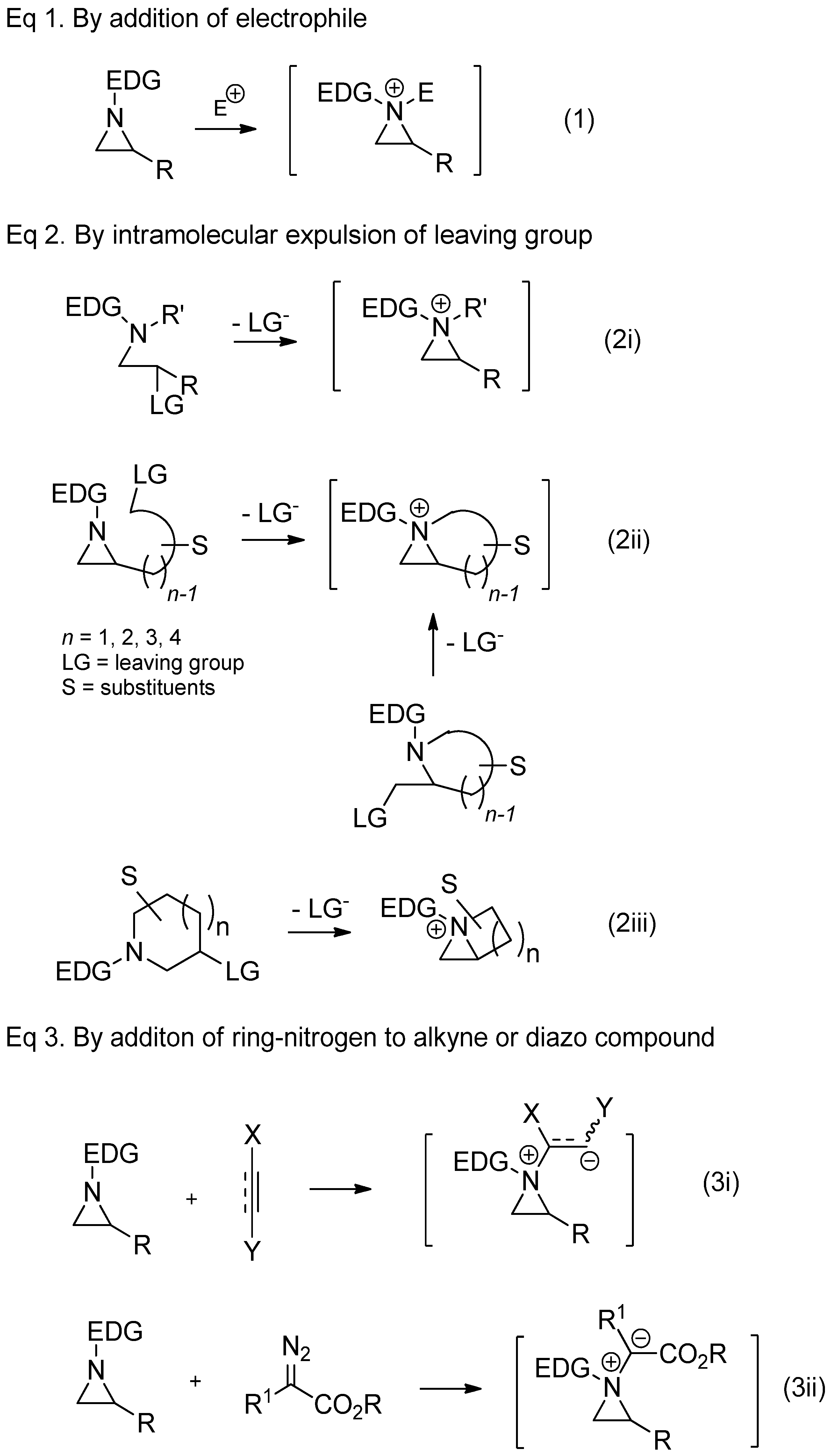
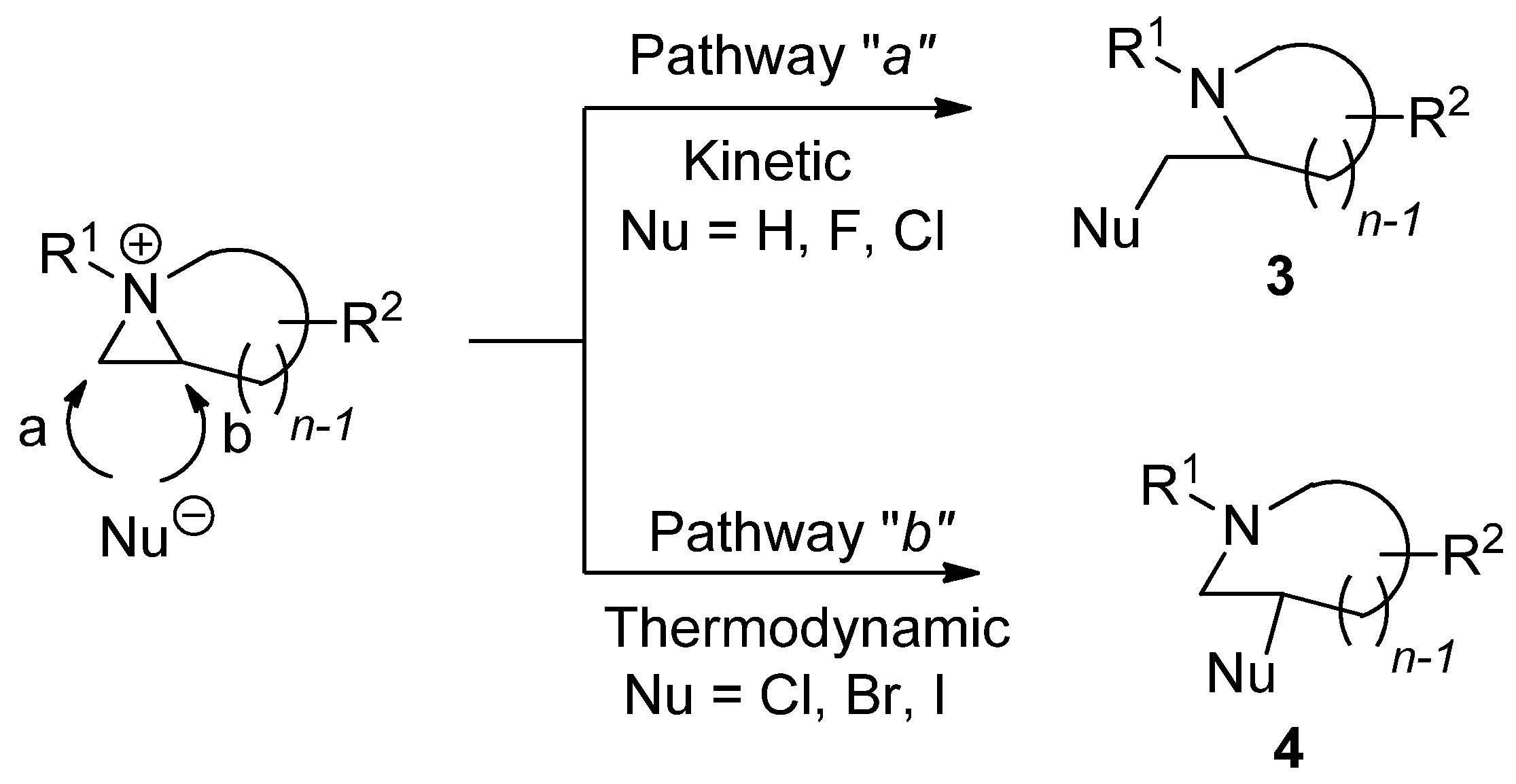
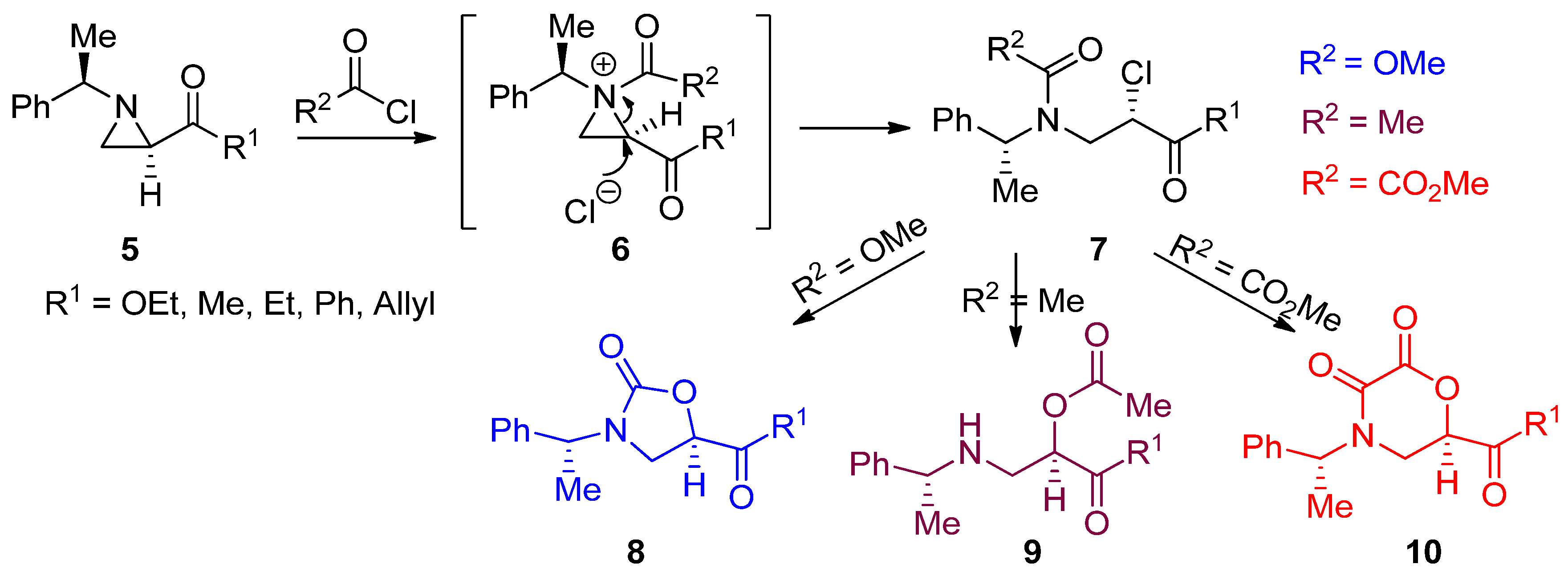

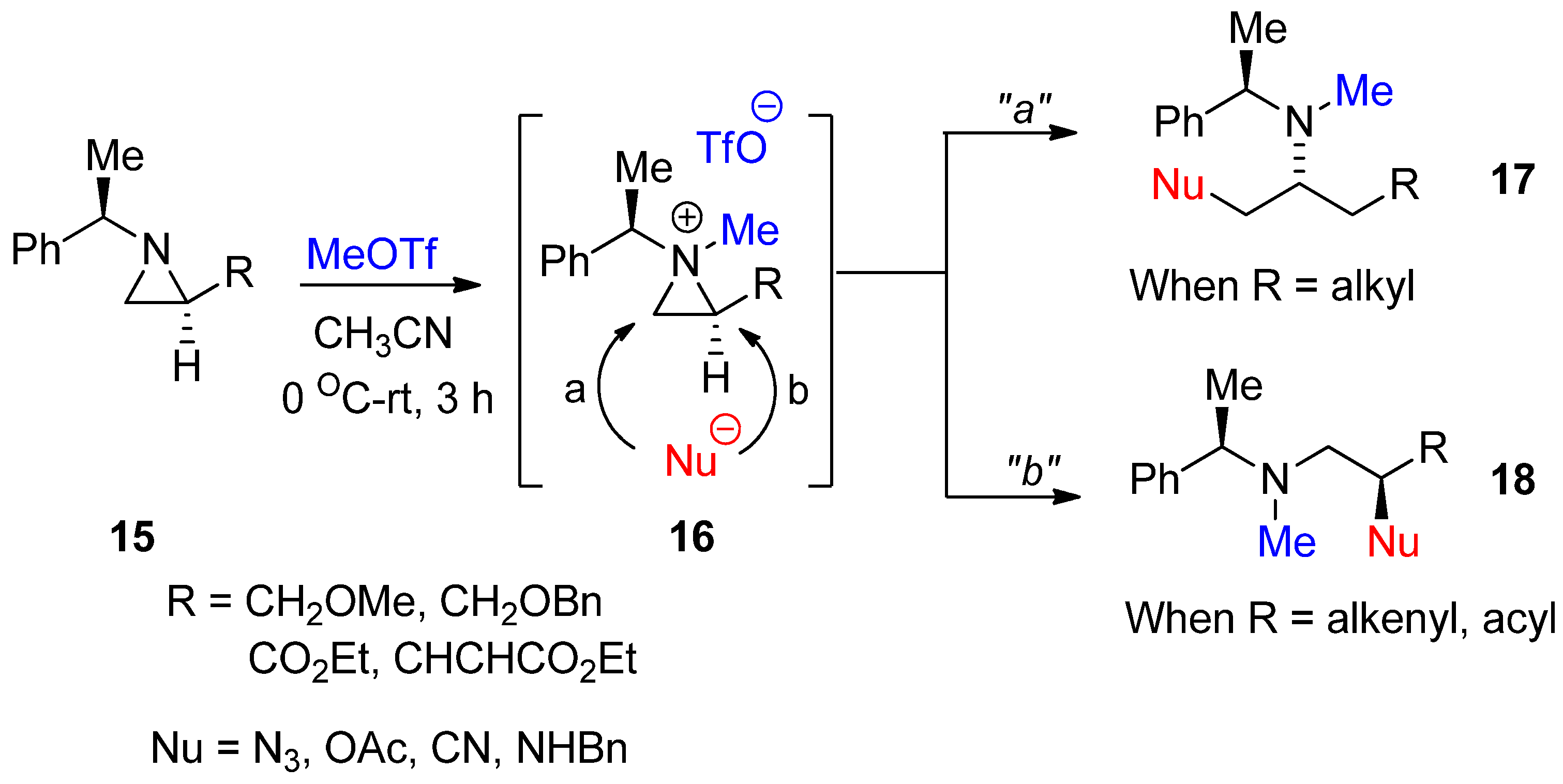

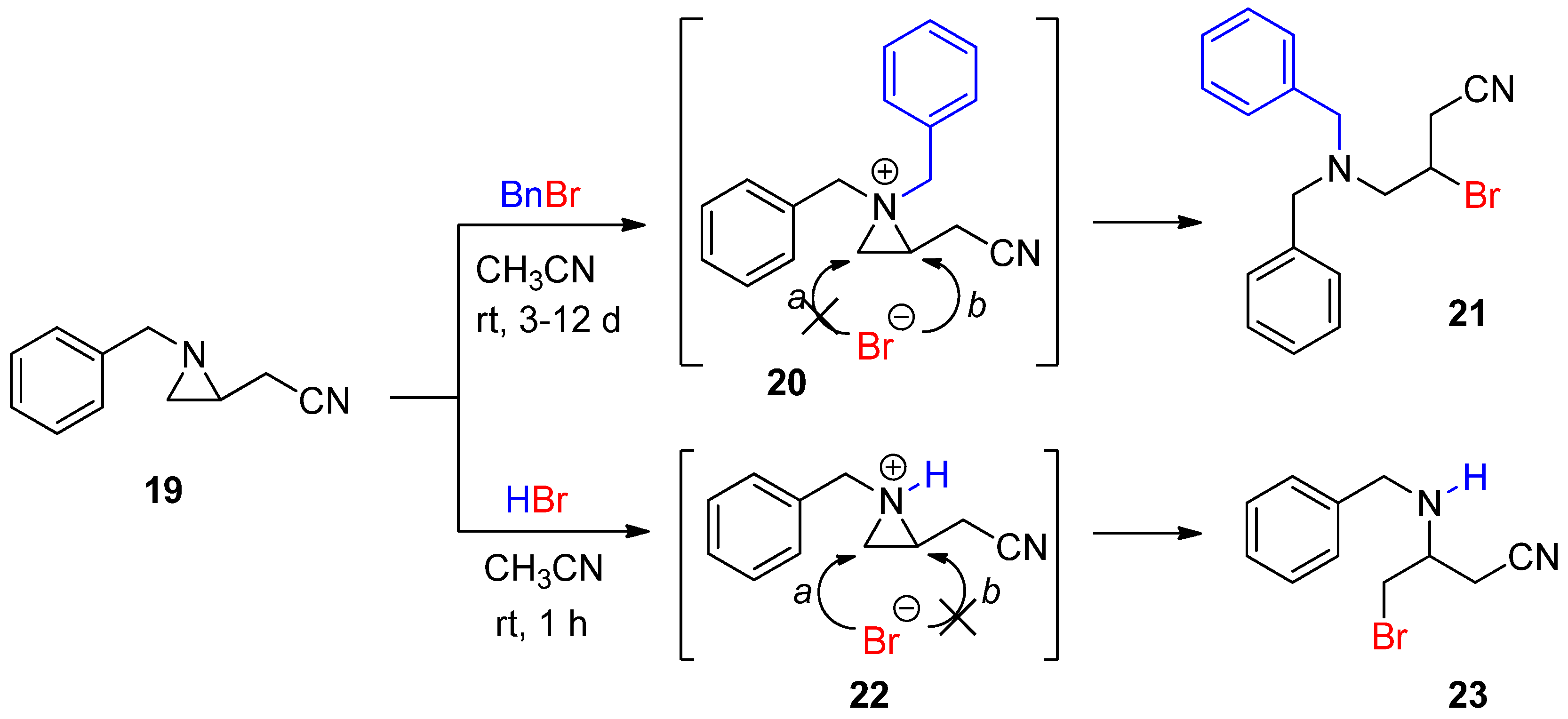

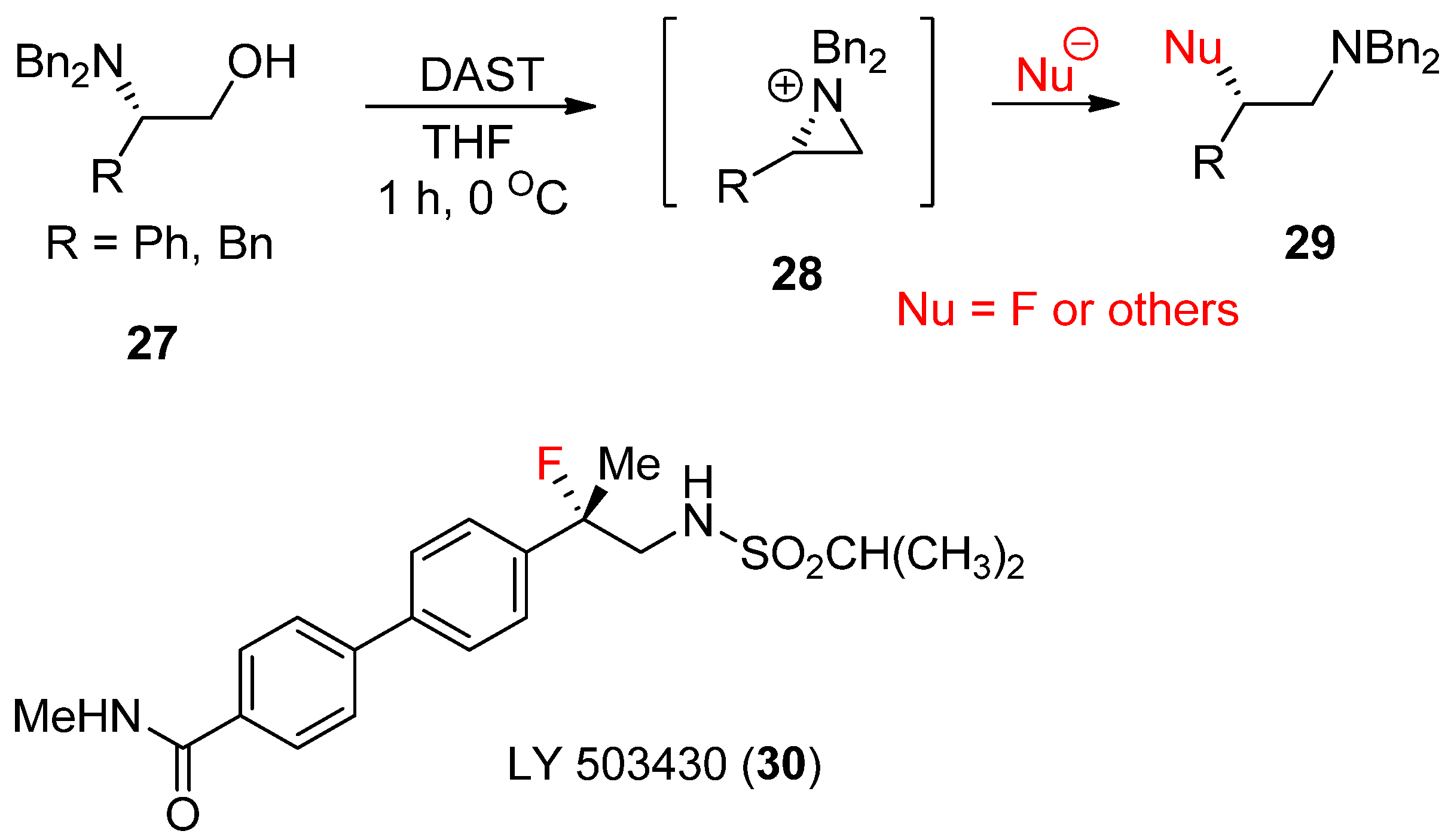

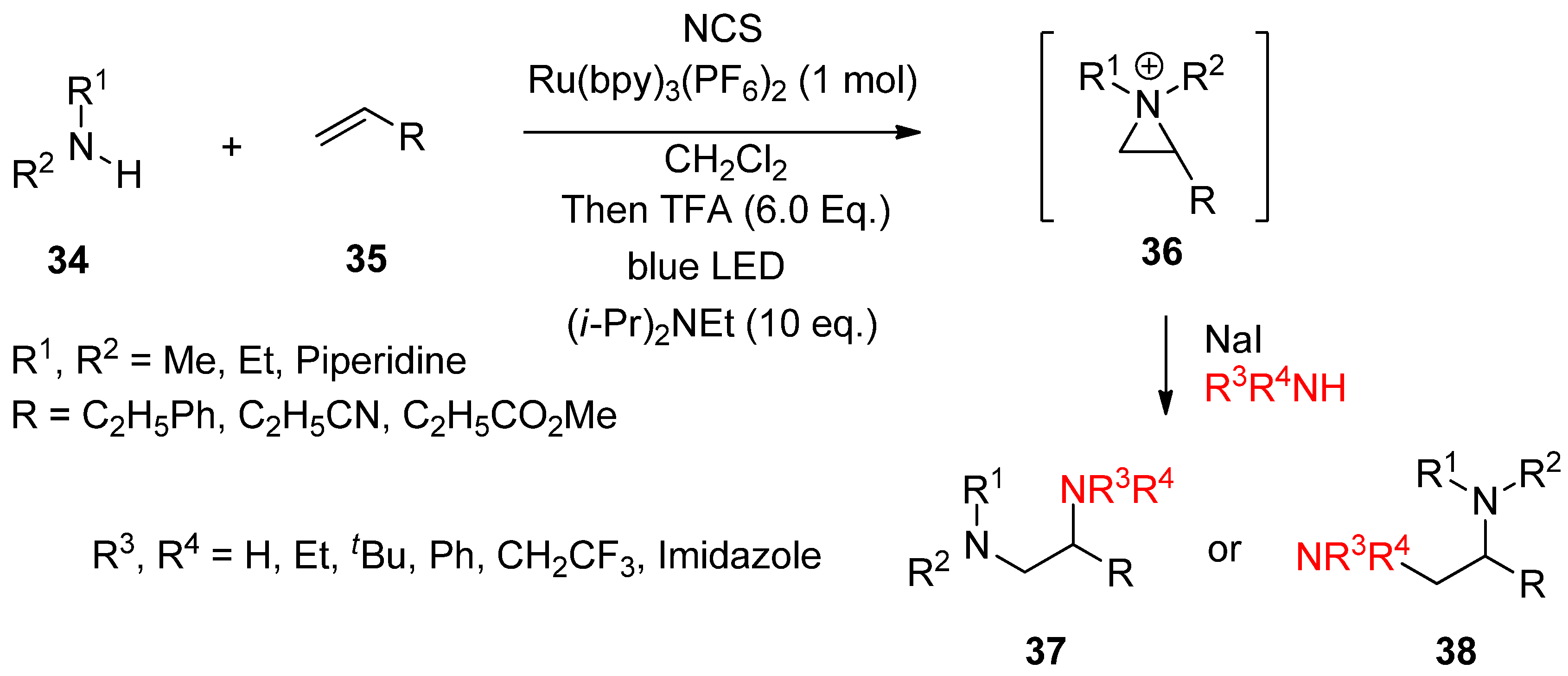









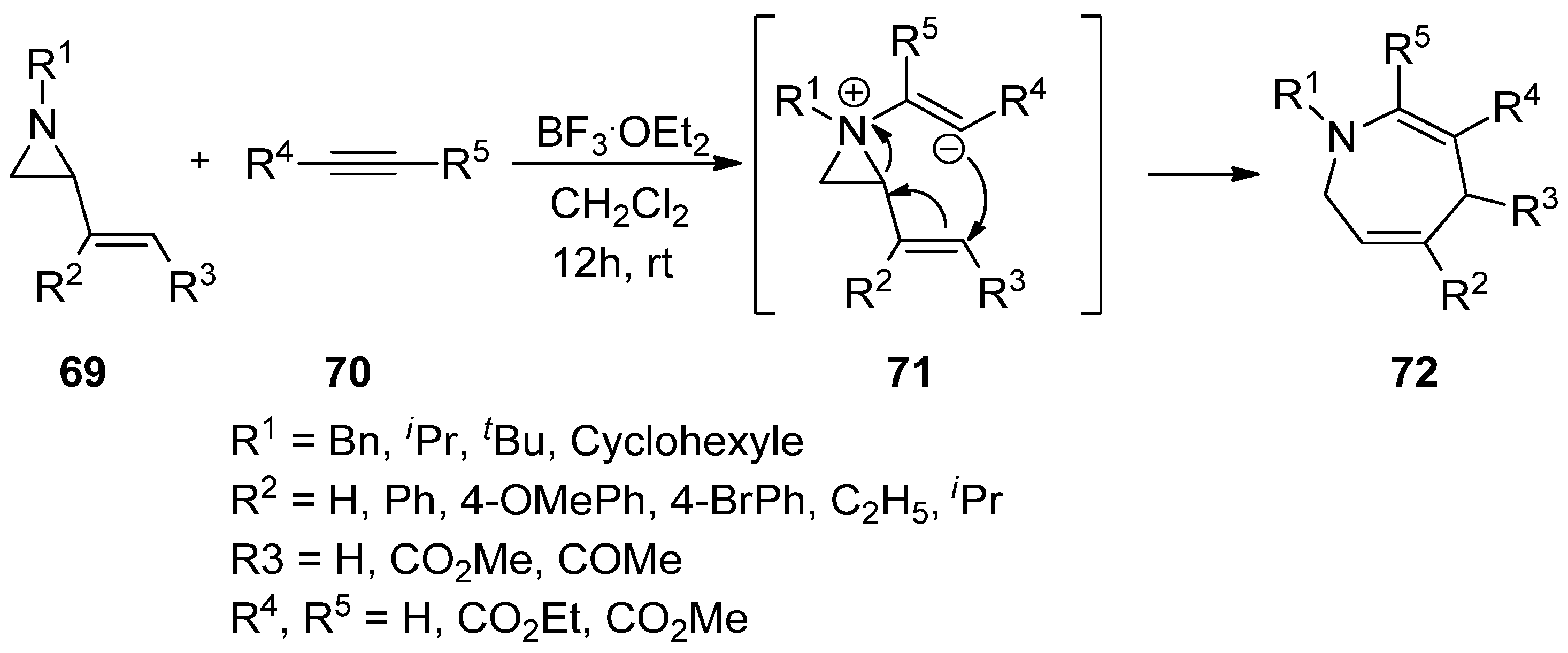

| E+ | Lewis Acid | RCO+ | H+ | R+ | TMS+ | |
|---|---|---|---|---|---|---|
| R1 | ||||||
| –CH=CH2, –CH=CH–COOEt | C2c | C2 | C2 c | C2 | C2 | |
| Aryl | C2 | C2 | C2 | C2 c | C2 c | |
| COR, COOR, CONH2 | C3 | C2 | C2 | C2 | C2 | |
| Alkyl | C3 | C3 and/or C2 a | C3 | C3 b | C3 | |
Publisher’s Note: MDPI stays neutral with regard to jurisdictional claims in published maps and institutional affiliations. |
© 2021 by the authors. Licensee MDPI, Basel, Switzerland. This article is an open access article distributed under the terms and conditions of the Creative Commons Attribution (CC BY) license (http://creativecommons.org/licenses/by/4.0/).
Share and Cite
Ranjith, J.; Ha, H.-J. Synthetic Applications of Aziridinium Ions. Molecules 2021, 26, 1774. https://doi.org/10.3390/molecules26061774
Ranjith J, Ha H-J. Synthetic Applications of Aziridinium Ions. Molecules. 2021; 26(6):1774. https://doi.org/10.3390/molecules26061774
Chicago/Turabian StyleRanjith, Jala, and Hyun-Joon Ha. 2021. "Synthetic Applications of Aziridinium Ions" Molecules 26, no. 6: 1774. https://doi.org/10.3390/molecules26061774
APA StyleRanjith, J., & Ha, H.-J. (2021). Synthetic Applications of Aziridinium Ions. Molecules, 26(6), 1774. https://doi.org/10.3390/molecules26061774





